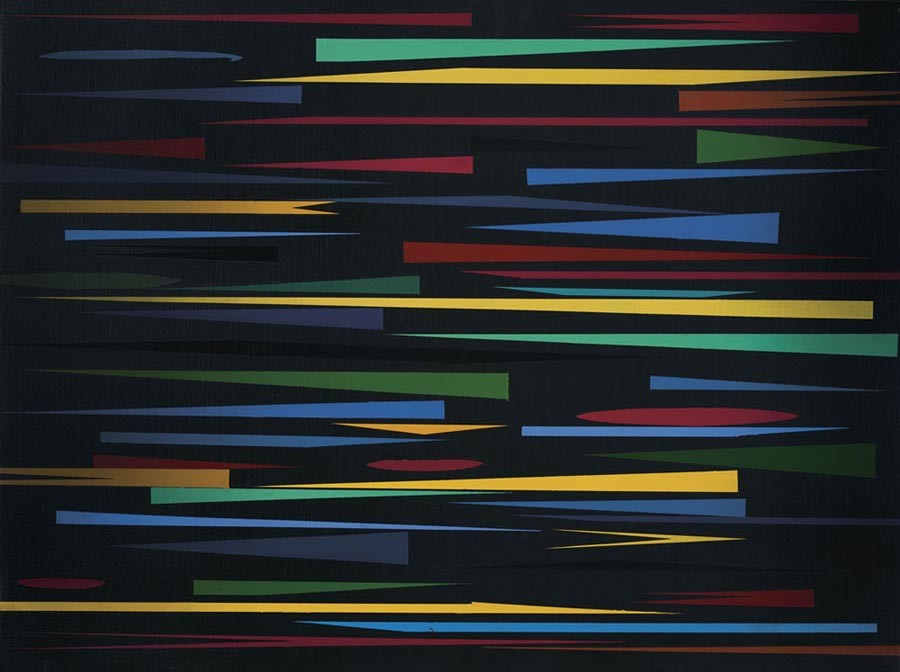
Nadia Khawaja’s recent exhibition at Canvas Gallery shows there are more ways and means to deal with a national symbol

What is important about August 14 is not those rehashed, predictable and boring speeches, but the fluttering of flags in the sky, on roads and in children’s hands. Nationhood everywhere is all about unity -- or even uniformity. A country means one language, culture, dress and religion. The idea of one faith is so ingrained that during the admissions of an art college, a faculty member innocently inquired from a Hindu applicant from Hyderabad if she was Indian.
States across the world recognising this yearning for singularity have come up with the idea of objects that signify national identity -- flag, currency, anthem, airline, radio, TV and, in some instances, art.
However, the general public does not subscribe to a strict concept of uniformity when it comes to national day celebrations. For instance, during the month of August, consider yourself lucky if you are able to spot two flags of identical shades of green, or similar direction of crescent or same proportion of star. Then there have been popular additions to an otherwise sober flag; from inserting the profile of Quaid-e-Azam to printing the portrait of Mickey Mouse. These reveal the basic truth -- that in comparison to the official narrative, people’s version triumphs at the end.
What our public does to the national flag, Nadia Khawaja does in art but with a different strategy, intention and mood. In her paintings, she too is dealing with the notion of nationalism but in a subtle and sensitive manner. Her work reflects an inquiry rather than an inquisition. Immaculately created paintings in impressive scale suggest how an artist looks at something that is so familiar and is often forgotten; it turns into an image loaded with personal matter and societal substance.
Her work from her solo exhibition Play Along (from Oct 3-12, 2017 at Canvas Gallery in Karachi) is mainly constructed by joining the flags of different countries. In reality, it is merely an appearance. Inspired by the format of flag, the artist has used it to create compositions which may look like assemblage of flags but are actually hard-edged shapes of varying hues on canvas.
To start with, a flag is a hard-edged visual designed by a person; so it is an artwork of sorts before it is accepted and revered as a national icon or a sacred symbol (you are not permitted to desecrate the flag of your own country or a friendly nation, while you are allowed, and in some cases encouraged, to burn, trample or tear the flag of ‘enemies’). Khawaja has approached the idea of art within that jumble of nationhood. She joins stripes of these flags with each other in order to make visuals which come from different countries’ national flags but are tuned and toned down to become one large and engaging ‘abstract’ composition. In the process, she leaves out signs, such as swords, crescent and stars, lion with sword, wheel, maple leaf, eagle etc. which are a part of many national flags.
Instead, her approach is minimal and meaningful. Leaving aside these ‘forms’ which signify religion, history, race, or political system of a country, they can be understood as the artist’s attempt to comment upon the division of world into these domains which are meaningless and a late phenomenon anyway. The combination of different flags as part of one big image is not much different from her earlier work in which the lines of text denote the percentage of a person’s nationality, based upon his/her living in different countries. So, what Khawaja tried to communicate through that work was the impossibility of a purity of race. In her new works, similar ideas are invoked but in a more poetic and passionate way.
Passionate because all her canvases are covered with precise shapes, painted in flat and even colour. The work looks extremely charged because the way Khawaja composes her visuals and constructs compositions, invokes strong sentiments and powerful reactions among the viewers. A sense of repose, a feeling of movement, an idea of speed can be all seen; yet the way of creating these works is precise, calculated, and controlled.
Along with Nadia Khawaja’s concerns about these visuals of national significance, it is the painter’s quest of how an apparently coldly handled canvas can generate warmth and excitement among the viewers. One quietly looks at her abstract paintings at the Canvas Gallery, (which are not flags any more, since some of these emerge from arrangements of colours), as one is accustomed to be in the presence of any national icon. But actually, the formal construction of these flags -- which at the end cease to be flags and are just patches of flat, stretched, elongated, subdued or strong colours -- overpower a viewer through the sophistication of their aesthetic quality.
Experiencing her works, with their genesis in national flags and nationalities, one recalls Arundhati Roy’s public address in Lahore many years ago in which she had pronounced that all national flags should be used as loin cloths. One wishes the great Indian writer visits Khawaja’s exhibition to see that there are more ways and means to deal with a national symbol -- deconstruct it and reconstruct in art.